Borneo Elephant
Elephas maximus borneensis
The smallest species of elephant!
Advertisement
Borneo Elephant Scientific Classification
- Kingdom
- Animalia
- Phylum
- Chordata
- Class
- Mammalia
- Order
- Proboscidea
- Family
- Elephantidae
- Genus
- Elephas
- Scientific Name
- Elephas maximus borneensis
Read our Complete Guide to Classification of Animals.
Borneo Elephant Conservation Status
Borneo Elephant Facts
- Main Prey
- Grass, Fruit, Roots
- Distinctive Feature
- Long trunk and large feet
- Habitat
- Rainforest and tropical woodland
- Predators
- Human, Tiger
- Diet
- Herbivore
- Average Litter Size
- 1
- Lifestyle
- Herd
- Favorite Food
- Grass
- Type
- Mammal
- Slogan
- The smallest species of elephant!
View all of the Borneo Elephant images!
The Borneo elephant is a subspecies of the Asian elephant and the only member of the species to reside on the island of Borneo.
This subspecies also goes by the alternative name of pygmy elephant. However, there is nothing small about this gigantic creature. By any measurement, it is still the largest land animal on the island of Borneo. Much about its behavior remains unknown. Until the World Wildlife Fund attached satellite collars to a few Borneo elephants in 2005, most of what we know about this subspecies was based upon extrapolation from the study of other Asian elephants. As its fate hangs in the balance, it’s now a race against time to save it from extinction.
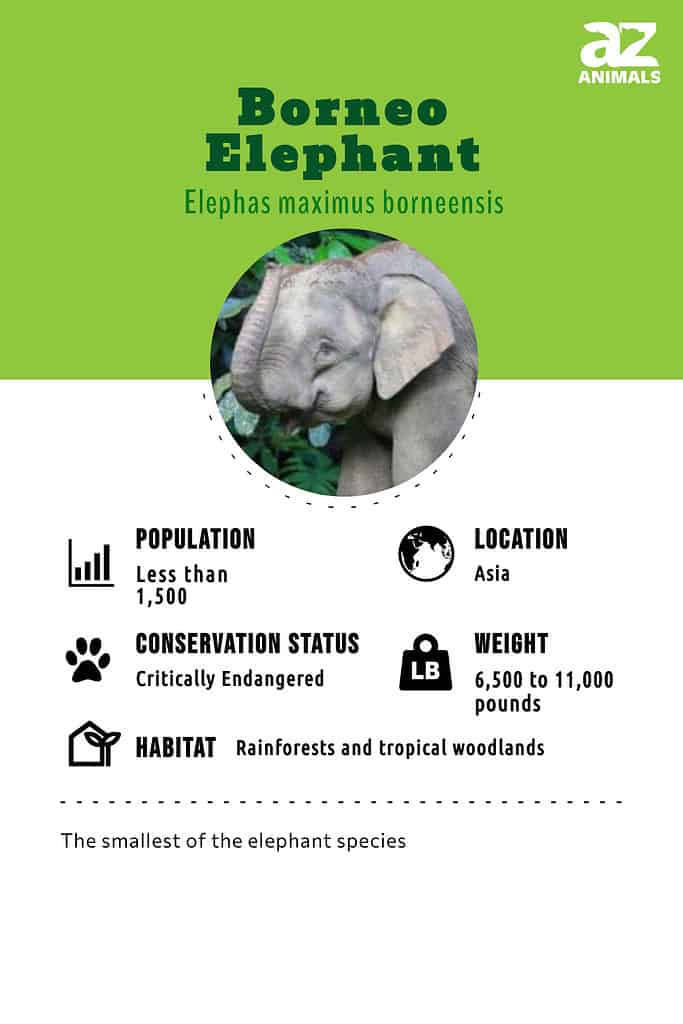
4 Incredible Borneo Elephant Facts
- The Borneo elephant last shared a common ancestor with its Asian kin about 300,000 years ago. Isolated from the other subspecies, it has evolved separately on the island of Borneo, never exchanging genes with other populations of elephants.
- Asian elephants grow six sets of teeth throughout their lives.
- Female Asian elephants usually lack tusks, but they do have long teeth called tushes located right behind their upper lips.
- The elephant trunk is an impressive instrument that’s almost akin to a human hand. One of the more amazing facts about it is the ability to break off branches and swat away flies.
Scientific Name
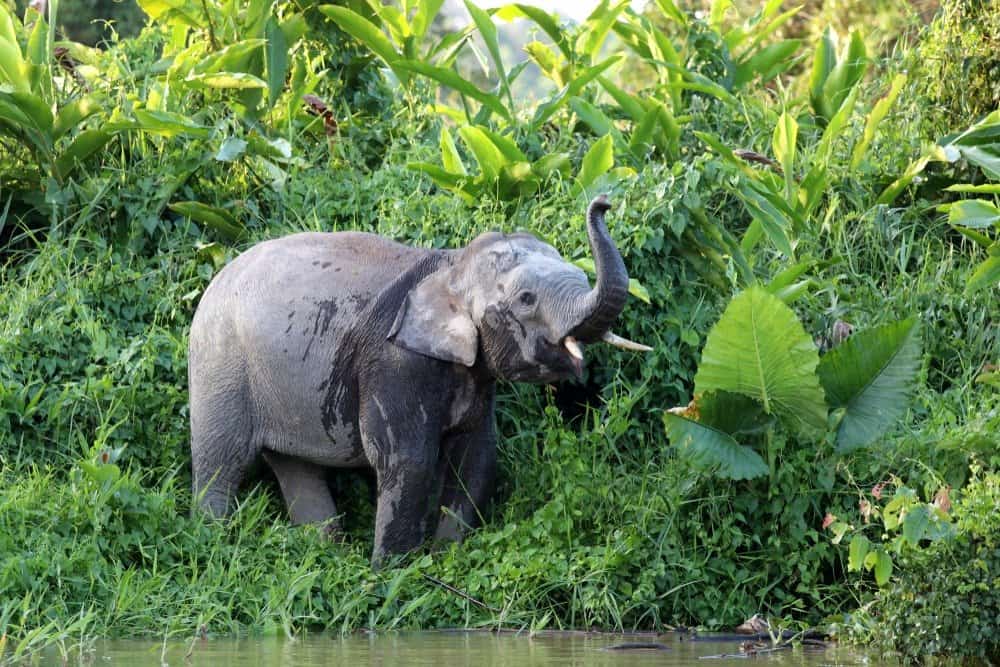
Borneo elephant is called Elaphas Maximus borneensis scientifically.
©Christian Edelmann/Shutterstock.com
The scientific name of the Borneo elephant is Elaphas maximus borneensis. Elephas is obviously the name of the elephant family that includes both African elephants and Asian elephants. Maximus is the precise scientific name of the Asian elephant species. As you might already know, it is a Latin term meaning greatest or largest, which reflects the size of the Asian elephant. It is also where we get the English term maximum. Borneensis, a Latinized word for Borneo, refers only to the specific subspecies of Borneo. There are actually four subspecies of the Asian elephant in total. The other three are the Sri Lanka elephant, the Sumatra elephant, and the Indian elephant. It is believed that the Borneo elephant has evolved far enough away from its Asian counterpart to warrant a separate subspecies designation.
Evolution and Origins

Borneo elephants have been evolving for 60 million years.
©Christian Edelmann/Shutterstock.com
Elephants are part of a group of mammals called proboscideans, which also includes extinct species such as mammoths and mastodons. The earliest known proboscideans lived around 60 million years ago in what is now North Africa and were small, rodent-like creatures. Over time, these animals evolved larger bodies and more complex teeth that allowed them to eat tough plant material.
Around 25 million years ago, the first true elephants appeared in Africa. These animals had elongated snouts (or trunks) that they used for grasping food and water, as well as tusks for defense and digging up roots. They also had large molars with ridges that helped them grind down vegetation.
Over millions of years, elephants continued to evolve and spread across the world. Some populations migrated to Asia, while others remained in Africa. Today there are three living species: African bush elephants (Loxodonta africana), African forest elephants (Loxodonta cyclotis), and Asian elephants (Elephas maximus). Each species has its own unique adaptations based on their habitat and diet.
Despite their impressive size and strength, modern-day elephant populations face numerous threats from human activities, such as poaching for ivory or habitat loss due to deforestation or development projects. Understanding their evolution can help us better appreciate these incredible animals’ place in our planet’s history while emphasizing the importance of conservation efforts.
Appearance

©ylq/Shutterstock.com
The Borneo elephant shares many features in common with its Asian relatives: the two-domed head, the smaller rounded ears, the four hooves on the hind foot, and the gray skin with tiny spouts of hair. But it also exhibits many physical differences, including straighter tusks and a longer tail. The Asian elephant is generally smaller than the African elephant, but the Borneo elephant is around 30% smaller than other Asian elephants. Small, in this case, is relative since the Borneo elephant measures between 8.2 and 9.8 feet tall and between 6,500 and 11,000 pounds in weight. Males tend to have a much larger weight than females on average.
Behavior
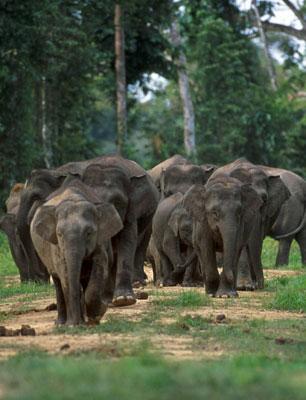
Borneo elephants use their trunk for dozens of purposes.
©Cede Prudente, World Wildlife Fund, Malaysia / Creative Commons
The elephant trunk is an all-around incredible instrument. Thanks to the large concentration of muscles and nerves, it is the main means through which the elephant interacts with the world: breathing, smelling, drinking, communicating, and grabbing objects. (It also has a finger-like appendage on the end to help with this.)
The elephant needs an equally impressive brain to perform all of these amazing feats with its trunk. Borneo elephants have not been widely studied for their cognition, but the elephant family as a whole has a highly developed neocortex (similar to humans, apes, and dolphins) that enables it to use tools, recognize itself in the mirror, solve complex problems, mimic behavior, and feel a range of complex emotions. Observations suggest that the elephant can experience grief and mourning over the death of a close friend or family member.
The herd is the center of all social activity and daily life for some elephants. This highly cooperative and altruistic unit consists of five to 20 adult females (called cows) and their offspring. The male bulls usually wander off on their own at a young age or join all-male bachelor groups, but the females tend to stay with the same herd for much of their lives. The oldest and largest female typically becomes the matriarch of the entire herd. She helps the group make decisions and instructs younger mothers on how to care for their young.
The Asian elephant is a crepuscular species, which means it sleeps during the day and accomplishes most of its activities during the dawn and dusk hours. Defying its rather cumbersome stereotype, the elephant is a fast runner and a surprisingly good swimmer. It can submerge its entire body in the water to stay cool. Only its trunk is visible above the water to help it breathe. The elephant will also cover itself in mud or soil to keep its body temperature down during the warmer months.
The life of the herd revolves around a nomadic existence. This means it wanders around a massive territory in search of waterholes and abundant sources of food. Multiple groups will sometimes join together based on the season, habitat, and other conditions.
Habitat
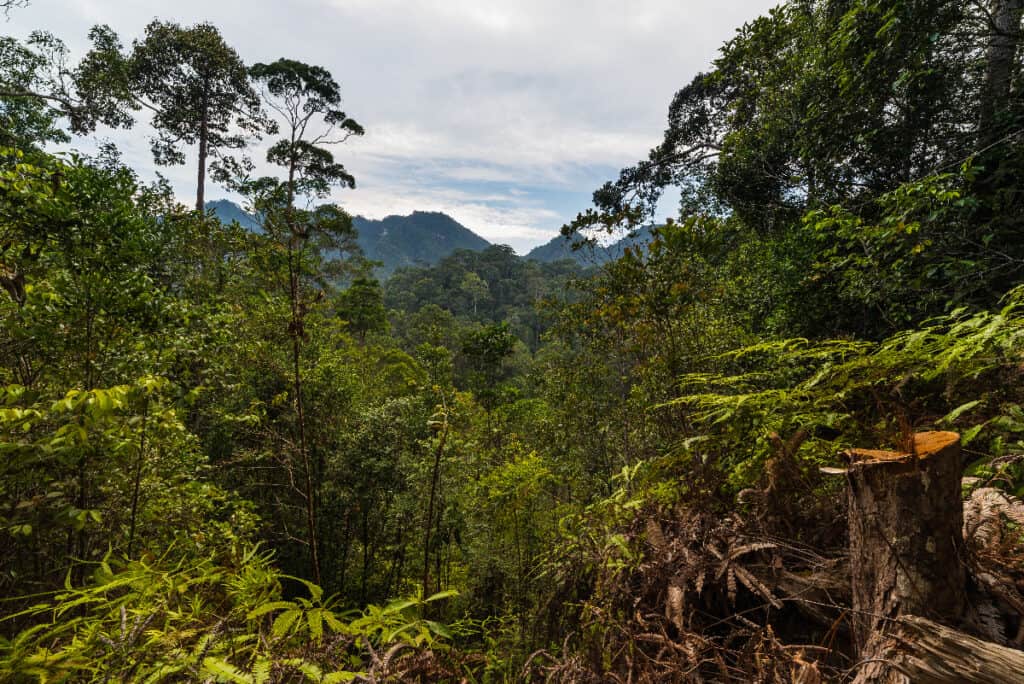
The Borneo Lowland Rain Forest are the only home of the Borneo Elephant.
©Fabio Lamanna/Shutterstock.com
The Borneo elephant, as the name implies, is endemic to the northeastern part of the island of Borneo. Although isolated from the rest of Asia, Borneo is one of the largest islands in the Pacific and a source of immense biodiversity. The greatest concentration of the Borneo elephant is found in the Malaysian state of Sabah at the very northern tip of the island. Here it wanders the forests and grasslands for 12 to 18 hours a day in search of resources.
Diet

The Borneo elephant is an herbivorous animal that feeds on a diverse diet of different plant species, including flowers, fruits, leaves, grains, and bark. In order to sustain itself, one elephant alone may consume hundreds of pounds of food in a single day either by grazing along the ground or browsing on the leaves and shoots of trees. The trunk functions as a versatile limb that can grasp vegetation and bring food to its mouth.
Predators and Threats
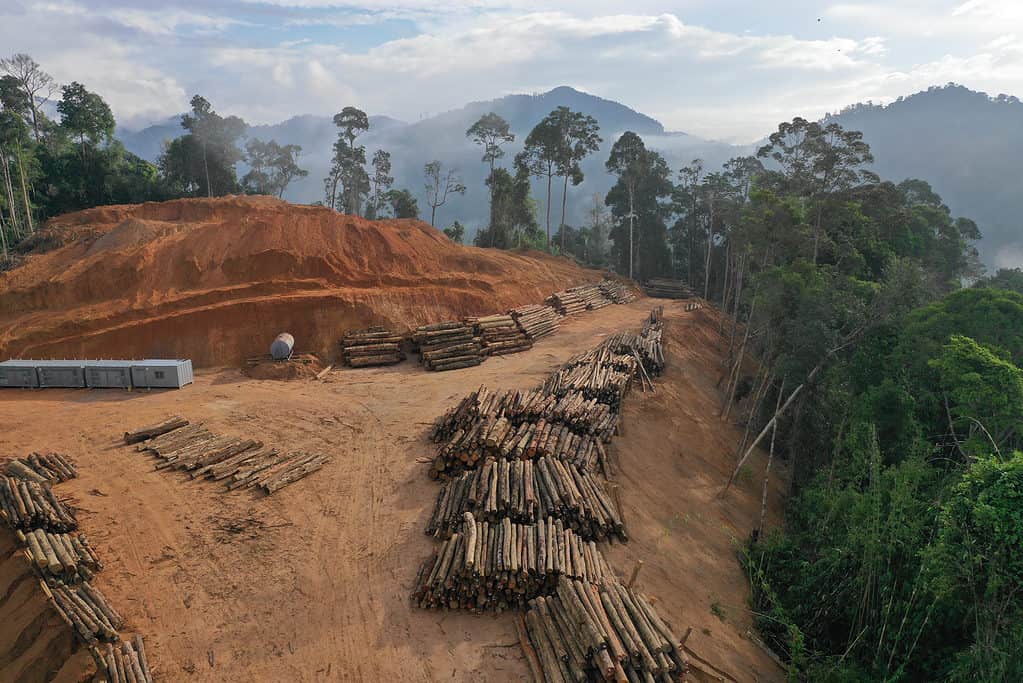
Deforestation is one of the many threats to the Borneo elephant’s survival.
©Rich Carey/Shutterstock.com
Because of its formidable size, the Borneo elephant has nothing to fear from any natural predators. Even the youngest elephants are quite large and, in any case, protected by the herd. The only real threat is humanity. Because this subspecies requires a large amount of land in which to live, deforestation for logging, agriculture, and plantations has degraded its natural habitat, which not only creates fragmented populations but also leads to direct confrontation with people. Elephants are sometimes killed or harmed because they accidentally destroy crops as they move through farms and plantations. Some elephants are just the victim of unfortunate circumstances. It is estimated that around 20% of this subspecies has sustained injuries from illegal snares to catch smaller game.
Reproduction, Babies, and Lifespan

Borneo Elephants are pregnant for 22 months and give birth to 100-pound babies.
©iStock.com/Edwin_Butter
The reproductive habits of the Borneo elephant are not well studied, but based on what we know about other Asian elephants, several facts can be extrapolated. The most important element of male sexual behavior is a temporary condition called musth. During these periods, the male’s hormones become elevated, and the testes are enlarged. This allows the male in musth to compete with other elephants (who are usually not in musth) for the sexual rights of the female by wrestling, pushing, or ramming with their tusks. The weaker male will yield to the stronger male before these competitions turn too into a serious and deadly fight. This system tends to favor older males because musth gains in intensity with age.
Although elephants can mate all year round, it is believed that the female elephant is reproductively receptive for only a limited time of the year. She will demonstrate her sexual availability through various vocalizations and movements, triggering the males to compete for her affection. It is usually her choice whom she will mate with, but she prefers males who are in musth because it’s a signal of strength and dominance.
After copulation, the male will sometimes stay with the female just long enough to prevent her from mating with anyone else, but he otherwise plays no role in parental care. Once the father leaves, the female carries the young offspring for about 22 months, which is perhaps the longest of any mammalian species in the world. She produces only a single calf at a time, and rarely does she have twins. This is because the Asian elephant has an exceptionally long development time.
Although they start out weighing more than 100 pounds, the calves need a lot of growth before reaching their full size. The child will nurse on its mother’s milk for at least two years after birth, but full weaning doesn’t occur for almost four years. During this time, both the mother and her relatives will take an active role in the calf’s development. They will provide the calf with protection and tutelage until it is ready to become independent. Because of the massive investments required to raise the offspring, she only breeds once every four to five years.
Both males and females tend to become sexually mature at around 10 to 15 years of age. If the elephant is stressed, then sexual maturity may be delayed by several more years. The typical life expectancy of this species is around 50 years in the wild, though some individuals can live up to 60 or 70 years.
Population
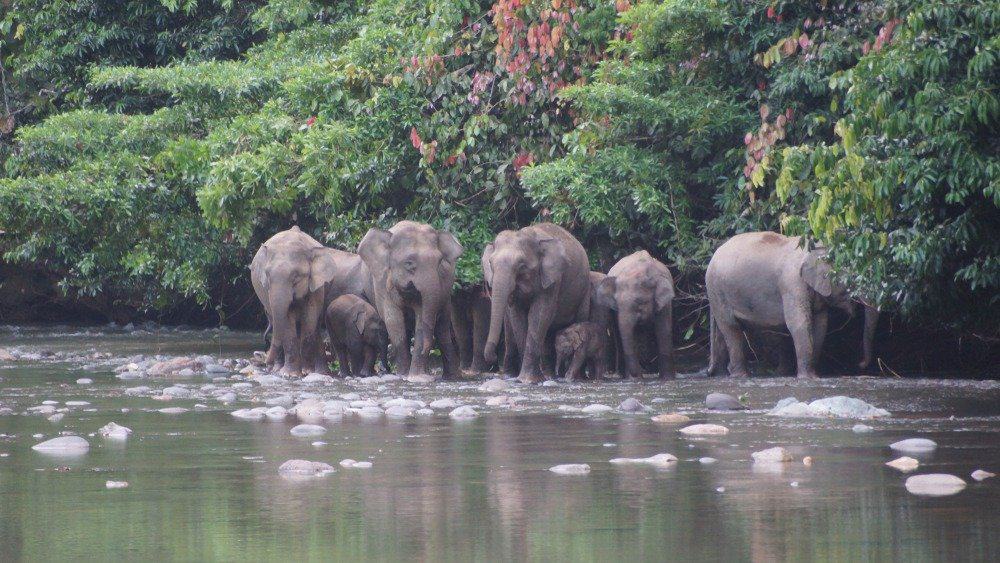
There are only 1,500 Borneo elephants left in the world.
©Craig Ansibin/Shutterstock.com
The Borneo elephant is a critically endangered species, with fewer than 1,500 individuals remaining in the wild. It is estimated that population numbers have fallen some 60% since 1980. In order to create more sustainable foresting practices, some organizations like the World Wildlife Fund are working with local plantation managers and owners near the elephant’s habitat to create reforested wildlife corridors to enable free movement between fragmented areas. This should also reduce conflicts with humans.
Borneo Elephants in the Zoo

Borneo Elephants can be viewed at Oregon Zoo
The Oregon Zoo has the only Borneo elephant in the United States: a female called Chendra. She was born in Sabah, Malaysia, in 1993 and was later found wandering around a palm oil plantation, hungry and alone, with wounds on her front legs and left eye. Unsuited for life in the wild, she came into the possession of the Oregon Zoo in 1999. Chendra is now housed in the elephant lands section along with other Asian elephants. This section has three interconnected outdoor spaces for the elephants to roam in, plus feeding stations, mud wallows, and a massive pool.
View all 285 animals that start with BBorneo Elephant FAQs (Frequently Asked Questions)
How many Borneo elephants are left?
It is estimated that there are only around 1,500 Borneo elephants left in the wild.
Why is the Borneo elephant endangered?
Deforestation from logging and plantations is the biggest threat to the elephant’s survival. It is estimated that some 1.3 million hectares of forest is lost in Borneo per year. A hectares is equivalent to 10,000 square meters. More than half of the forests have already been lost from their peak.
How big is a Borneo elephant?
The Borneo pygmy elephant can grow up to 9.8 feet tall and 11,000 pounds in weight. Despites its enormous size compared to most animals, this actually makes it one of the smaller types of elephants; hence the nickname of pygmy elephant.
What do Borneo elephants eat?
The diet of the Borneo elephant consists of leaves, shoots, fruits, bark, and whatever other plant matter it can find. In the diverse ecosystem of Borneo, there is no shortage of vegetation to choose from. This is necessary, because the elephant consumes close to 10% of its body weight in food every single day.
Where are Borneo elephants found?
The Borneo elephant is endemic to the forests and grasslands of northeastern Borneo.
How fast is a Borneo Elephant?
A Borneo Elephant can travel at speeds of up to 27 miles per hour.
How to say Borneo Elephant in ...
Thank you for reading! Have some feedback for us? Contact the AZ Animals editorial team.
Sources
- World Wildlife Federation, Available here: https://www.worldwildlife.org/species/bornean-elephant
- National Geographic, Available here: https://www.nationalgeographic.com/animals/mammals/a/asian-elephant/
- Brittanica, Available here: https://www.britannica.com/story/whats-the-difference-between-asian-and-african-elephants
- Animal Diversity Web, Available here: https://animaldiversity.org/accounts/Elephas_maximus/
- (1970) https://wwf.panda.org/discover/our_focus/forests_practice/deforestation_fronts2/deforestation_in_borneo_and_sumatra/? Jump to top

















